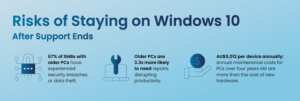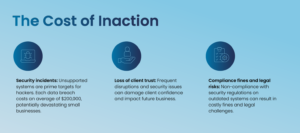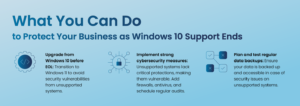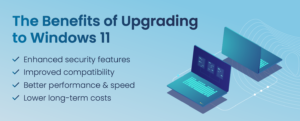A race against time.
As of October 2025, Windows 10 will officially reach its end of support (EOL). This has significant implications for businesses still running this operating system, as they may be exposed to many cybersecurity risks and operational challenges without regular security updates and patches from Microsoft. Here’s what you need to know.
Windows 10 EOL timeline
Microsoft has announced that support for Windows 10 will conclude on October 14, 2025. After this date, businesses can no longer rely on Microsoft to provide essential security patches or updates for this specific operating system. This end-of-support date serves as a crucial turning point for companies that depend on Windows 10 for their daily operations to switch to Windows 11 or newer versions.

How to remain protected
Failing to migrate to a supported operating system poses serious security risks. Without regular updates, systems running Windows 10 become increasingly vulnerable to malware, ransomware, and other cyber threats. As cyberattacks evolve, the absence of security patches puts your sensitive data at great risk. Additionally, compliance with industry standards often requires organisations to maintain up-to-date software; failing could expose your business to significant legal and financial consequences.

Outdated software puts cutting-edge hardware and applications at risk.
Using outdated software can lead to compatibility issues with modern applications and newer hardware. As technology advances, unsupported systems may struggle to integrate with the latest tools and devices, resulting in increased downtime and degraded performance. Additionally, maintaining older hardware and software can drive up IT costs, diverting resources from more strategic initiatives.

Why upgrade?
Upgrading to Windows 11 or newer versions offers significant advantages. Transitioning to a supported operating system is a strategic move that safeguards your data and ensures your IT infrastructure remains future-proof. VITG offers strategic support for migrating services and platforms for your business. They’re ready to take you to the turning point of your operating system and will navigate the path for you.
A new study revealed that in the last year alone, as many as 67% of SMBs experienced PC security and data theft breaches, with only 22% actually reporting these attacks.
‘To put it simply, old technology is not equipped to withstand the cybersecurity issues that are now the norm in the business world of today,’ said Neil Gordon, Director of Consumer and Devices Sales, Australia and New Zealand, Microsoft. ‘Interestingly, our survey results showed viruses or other malware attacks and identity theft are the biggest PC security concerns among our small business community. This tells us Australian SMBs are aware of how advanced cyber-attacks have become.’
A simple software upgrade remedies the issues quoted above, thanks to the cutting-edge security and access to updates within the new OS.

Ready for tomorrow and beyond
Contact VITG for expert assistance in planning and executing your business’s operating system and hardware upgrade. VITG offers various options, including managed IT services, hardware assessments, and tailored consultations to determine the best upgrade path for your organisation. Proactive steps to protect operations and data are essential for any business. Upgrading your operating system isn’t just necessary; it’s a valuable opportunity to enhance your overall IT strategy. Don’t hesitate to contact VITG today for the support and guidance you need throughout this transition.
Windows EOL FAQs
Q: Will my systems continue to function after Windows 10 reaches end-of-life?
A: Yes, your systems will remain operational; however, they will be increasingly vulnerable to security threats and may encounter compatibility issues with newer applications and services.
Q: Can we upgrade to Windows 11 at no additional cost?
A: Organisations can upgrade for free if their Windows 10 PCs are running the latest version and meet the minimum hardware specifications required for Windows 11.
Q: What options are available if my hardware is incompatible with Windows 11?
A: Consider evaluating alternative operating systems such as Linux, maintaining Windows 10 (with a focus on security), or investing in new hardware to ensure continued support and security.
Q: What is the typical duration of the upgrade process to Windows 11?
A: The upgrade process usually takes 1 to 2 hours, though the time may vary based on your specific system configurations and network speed.
Q: Will data integrity be maintained during the upgrade to Windows 11?
A: Your data will generally remain secure during the upgrade. Nonetheless, to mitigate potential risks, it is prudent to perform a backup of critical data before implementing any major system updates.




